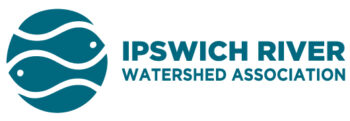On Monday October 15, Wayne Castonguay and I gave a Ipswich river main-stem dam tour to two dozen of NOAA’s Greater Atlantic Regional Fisheries Office Protected Resources Division staff. Operating under the Marine Mammal Protection Act and Endangered Species Act, this division consist of the following programs; Marine Mammal and Sea Turtle Conservation, Endangered Species Consultations (Section 7), Endangered Species Act Listed Fish and Species of Concern, and Endangered Species Listings, Monitoring, and Outreach. It was a large group, but we were able to stick together as we meandered down from the South Middleton Dam down through the Willowdale Dam and ended at Ipswich Mills.
Lead by Mark Murray-Brown, Section 7 Coordinator, the tour was part of the team’s yearly staff meeting which had a significant office component prior to the tour. While some attendees work to manage, conserve, and rebuild populations of marine mammals, others deal with endangered and threatened marine and anadromous species in rivers, bays, estuaries and marine waters of the Northeast.
In case you didn’t know, dam removal is an important aspect of river restoration because it:
- Improves public safety and community resilience to climate change.*
Extreme floods threaten dams and the roads, buildings, utilities that surround them. Under Massachusetts state law, dam owners can be held liable for injury or damage caused by the dam. When performed in a controlled manner, dam removal reduces hazards to upstream and downstream resources. - Restores river herring (Greater Atlantic Region, Species of Concern) and shad critical for offshore forage.
- Alleviates dam owners from public safety hazards, maintenance costs, and liability.
- Restores river functionality by removing artificial ‘pond’ habitat and stagnant water upstream of dam.
- Restores river habitat and allows fish and wildlife to access crucial river habitats when needed throughout their life cycle, without as much risk for predation.
- Restoration of river chemistry, through export of accumulated sediment and re-oxygenation of stagnant waters.
- Dam removals expand usable wildlife habitat, since the impacts of climate change may reduce or change wildlife habitat quality and quantity.
- Releases trapped sediment to freely move where intended naturally.
- Creates one of the rarest habitats in Massachusetts, Tidal Freshwater wetlands.
- Saves thousands of freshwater animals per day that are lost over the dam.
- Enhanced recreational opportunities such as fishing, boating and ecotourism surrounding herring runs.
Fun was had by all! River herring regulators were able to get a field view of the dam projects that may pass across their desks over the next few years, while those with more of a turtle affinity had the pleasure of saving a painted turtle who had unfortunately dropped below the Ipswich Mills Dam and was heading for inhospitable freshwater turtle habitat.
We would like to offer a heartfelt thank-you to the Protected Resource Team for all of the important work that they do to protect animals which have suffered unfortunate population declines due to changing climate, habitat loss and anthropogenic mortality.
*https://climateactiontool.org/content/restore-habitat-connectivity-remove-obsolete-dams
[blog_subscription_form title=”Subscribe For More River Updates”]

I have been hearing about the removal of south middleton dam for years. Each year they say they are going to do it. When is it really going to happen?
thanks
ken